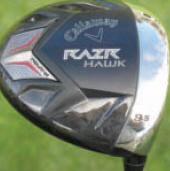Clubfitting Basics for the Driver
 No club in the bag gets as much technology put into it as does the driver. For some golfers, bashing the long ball is the most fun they have on the course.
No club in the bag gets as much technology put into it as does the driver. For some golfers, bashing the long ball is the most fun they have on the course.
A lot of emphasis is put on driving the ball long these days, and it seems to have overtaken the short game in importance in the minds of many golfers. Actually, driving distance is somewhat important. If the average course length that the average golfer plays is around 6,200 yards, and they hit the ball around 220 yards off the tee for the typical 14 drives, that means that the driver is responsible for 3,080 yards, or about half of the yardage. So, you can see that the driver is a pretty important club.
Too many of our students have drivers that are ill-fitted for them. Often you will see them struggle to get much height on the ball, even on good hits. While a low bullet was the preferred ball flight back in the days of balata balls, the modern ball requires a different flight. The mantra of high-launch and lowspin best suits what should be happening today.
There is a limit on how much height the ball should be hit, though. And, it may be beneficial for some golfers to hit the ball lower than what is considered optimal, since optimal involves carry distance. Golfers who play firm courses will probably find that they will get more overall distance (carry + roll) if they hit the ball lower than what will give them the most carry.
A launch monitor is the best tool for dialing in a student’s proper specs, but not everyone has one, nor are they always readily available. Without a launch monitor, how are we to determine if a student’s driver is not right for them?
While standing outside, reach your arm straight out in front of you horizontally. Now, raise your arm so your fingertips are as high as the top of your head. Your fingertips now approximate the top trajectory you should see most students’ drives reach. If your students’ drives are noticeably lower than this, they are likely shortchanging themselves when it comes to their drivers.
To get more height, a driver with more loft is needed. You might have seen some advertisements for shafts that promote higher launch angles, but primarily this is done through driver loft. One of the shaft’s functions is to affect backspin. Assuming your student’s launch angle is good, if their drives fall out of the sky fairly quickly, chances are they are not getting enough backspin. They need a shaft with a softer tip and a lower kick point. If their drives tend to “balloon” or upshoot, they are probably getting too much backspin and need a firmer-tipped shaft with a higher kick point.
In general, golfers who have fairly quick tempos and transition moves benefit most from firmertipped shafts, while those who have slower tempos and transitions will be fit best with softer-tipped shafts. A good source for shaft information is the Golfworks, and their online catalogue can be found at www.GolfWorks.com.
As for shaft flex, a very general guideline is that swing speeds from 85-95 mph should use regular shafts; swing speeds from 95-105 stiff shafts; and 105 and above extra-stiff shafts. This guideline is not hard-and-fast. For example, there might be those with swing speeds under 95 mph, but with very quick tempos, who will best be served with a stiff shaft, and those above 95 mph, but with very slow tempos, who should use regular shafts. A good rule of thumb is for the golfer to use the most flexible shaft that they can control.
If you clearly see that a student’s driver is not right for him, don’t hesitate to speak up. And, with the above information, you can probably steer them into driver specs that are very close to what they need. For more information on learning all about clubfitting, please contact jenn@usgtf.com.




